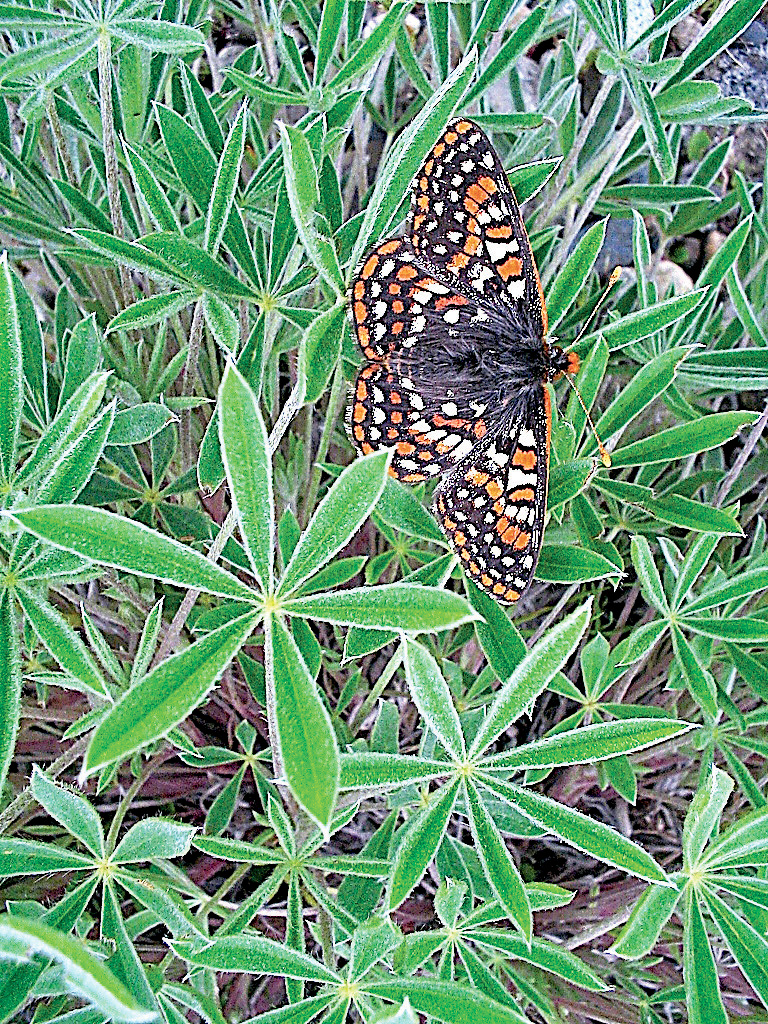PORT ANGELES — An endangered butterfly is holding its own in Clallam County, where seven of 11 known clusters of the Taylor’s checkerspot still exist.
Named for its orange-and-white checkered appearance, the 2-inch butterfly once flourished in Western Washington, Oregon and British Columbia.
More than 80 populations, or isolated groups, were documented by wildlife experts before a loss of habitat threatened to wipe out the colorful critter.
The Taylor’s checkerspot was listed in October 2013 on the Federal Register as endangered under the Endangered Species Act.
The state has listed it as endangered since 2006 with an active conservation program.
Ann Potter, a wildlife biologist with the state Department of Fish and Wildlife, said Clallam County is home to the “strongest part of the species in any range.”
Each population in Clallam County contains hundreds of individual butterflies, which generally stay within 100 meters of their home habitat.
“The Taylor’s checkerspot is pretty much a stay-at-home butterfly,” Potter said.
The checkerspot is usually found in an open, grassy field — a naturally bald area or a logging clearcut — with shallow soil.
All seven of the Clallam County populations are naturally occurring, meaning they are not the result of reintroduction efforts.
Four of the seven are in the Dungeness River drainage on U.S. Forest Service land, Potter said.
Two are west of Port Angeles near the Elwha River, and the seventh is a coastal population near a Dungeness Bay bluff.
The U.S. Fish and Wildlife Service said a loss of habitat from agricultural and urban development, tree encroachment and invasive plants contributed to the butterfly’s decline.
The four other remaining Taylor’s checkerspot populations are spread between the Willamette Valley, South Puget Sound and Vancouver Island.
Asked whether the species has a chance to make a comeback, Potter said: “I’m really hopeful, especially in Clallam County.”
Since butterflies need sunlight to hatch, the Olympic Mountain rainshadow “could be a contributing factor” to the relative success of the checkerspot in Clallam County, Potter said.
Part of the allure of the Taylor’s checkerspot is the fact that it is unique to the Pacific Northwest and has a “really interesting life cycle,” Potter said.
People have been fascinated by the “ugly-caterpillar-turns-into-a-beautiful-butterfly” cycle for thousands of years, she added.
“For us humans, the real value I think is what might be framed as an aesthetic value and also as a connection with nature,” said Potter, who specializes in threatened and endangered butterflies statewide.
“Once you come out and spend some time with the butterflies, you won’t have to be convinced about why to care.”
Much of what is known about the history of the Taylor’s checkerspot is marred by a lack of data, Potter said, as people were not necessarily looking for the species 50 years ago.
These days, state and local wildlife biologists, land managers and habitat specialists monitor the Taylor’s checkerspot and its host plants.
The state Department of Fish and Wildlife works with property owners and land managers to protect the butterfly by reducing shrubs and controlling non-native plants.
If an invasive species overtakes a checkerspot habitat, that population will go extinct, Potter said.
The largest population of the Taylor’s checkerspot is on an undeveloped prairie near an artillery impact range for Joint Base Lewis-McChord near Tacoma.
Military officials have said the butterfly’s listing as a federal endangered species last fall could lead to restrictions on Army training.
No restrictions have been proposed for butterfly protection in Clallam County.
“So far, land owners and land managers have all worked really hard to maintain these populations and even spent their own money to help with habitat restoration,” Potter said.
“I’m not aware of any project or incident in Clallam County where there’s been a kind of tension about this,” she added.
“We’ve worked with DNR [Department of Natural Resources], in particular, on a couple of road maintenance projects. They’ve been great. They’ve taken actions.”
Since the sides of logging roads make for prime butterfly habitat, DNR has installed rock barriers in certain places to prevent vehicles from plowing through plants where butterflies feed, mate and lay eggs.
The Taylor’s checkerspot hatches as a caterpillar on a host plant, then hibernates for months in the soil or under a rock.
Emerging from diapause, the black caterpillar absorbs as much sunlight as possible and becomes a butterfly sometime around May, depending on the elevation and spring weather.
Those who encounter a Taylor’s checkerspot are encouraged to take photographs of the butterfly and report the sighting to the state Department of Fish and Wildlife.
Potter can be reached at Ann.Potter@dfw.wa.gov.
“It’s part of the North Olympic Peninsula heritage there,” Potter said of the Taylor’s checkerspot.
“It something to enjoy and be proud of.”
________
Reporter Rob Ollikainen can be reached at 360-452-2345, ext. 5072, or at rollikainen@peninsuladailynews.com.
